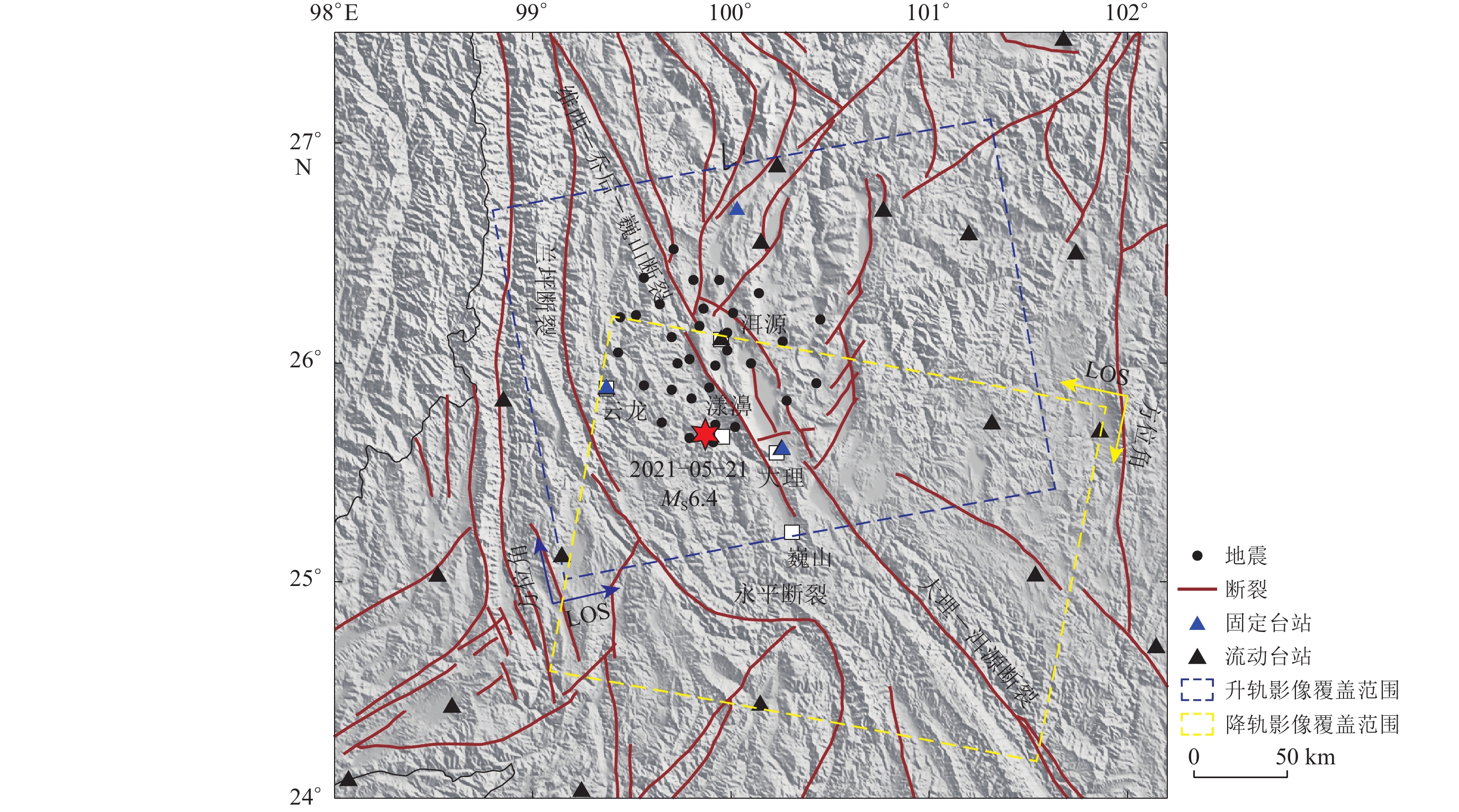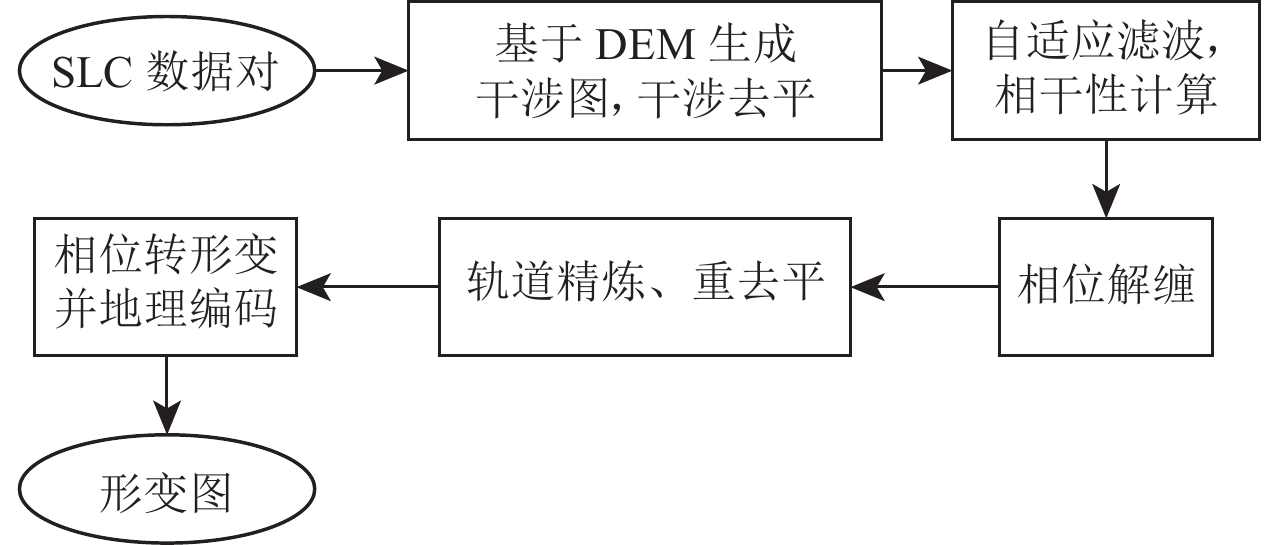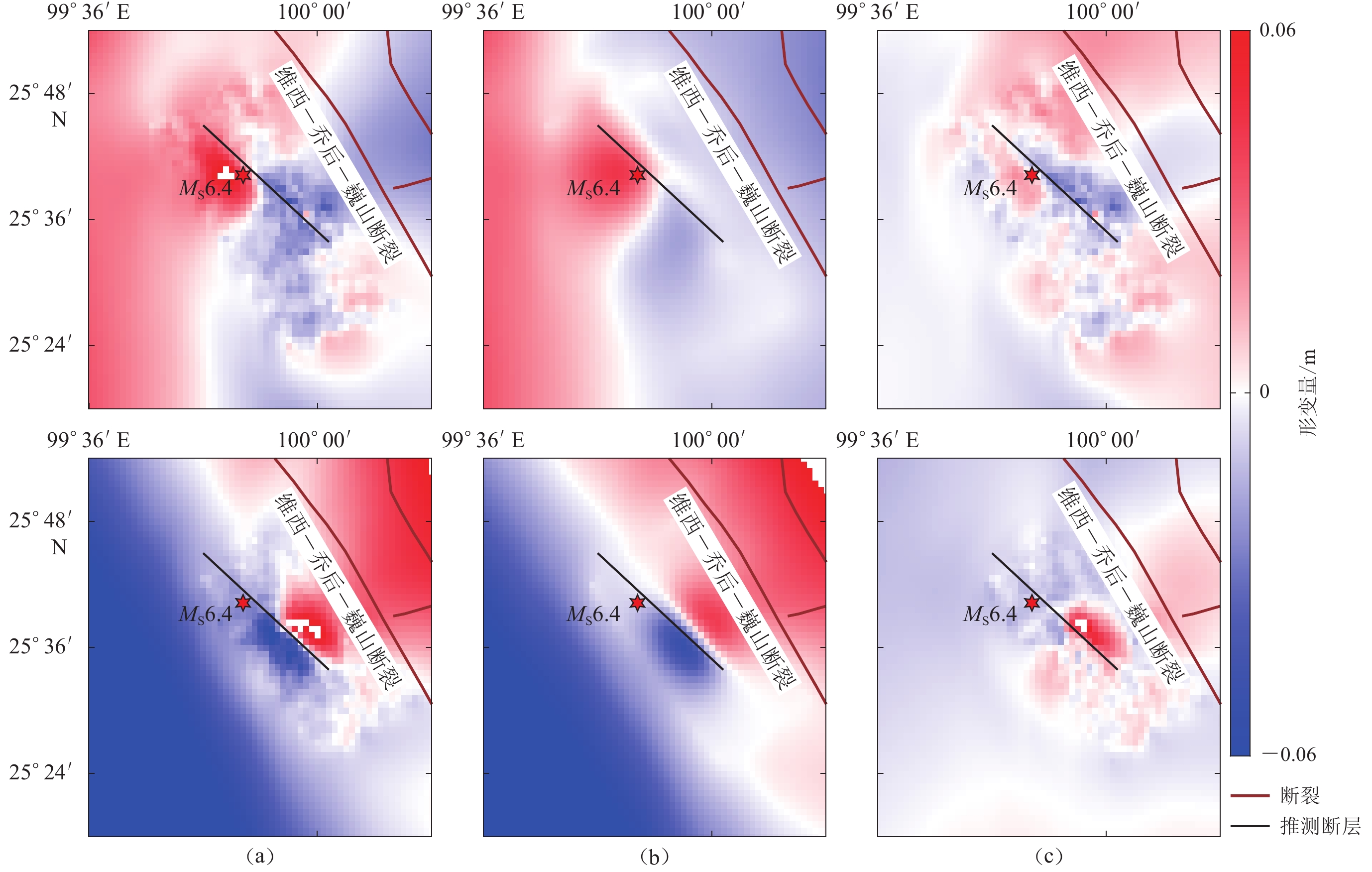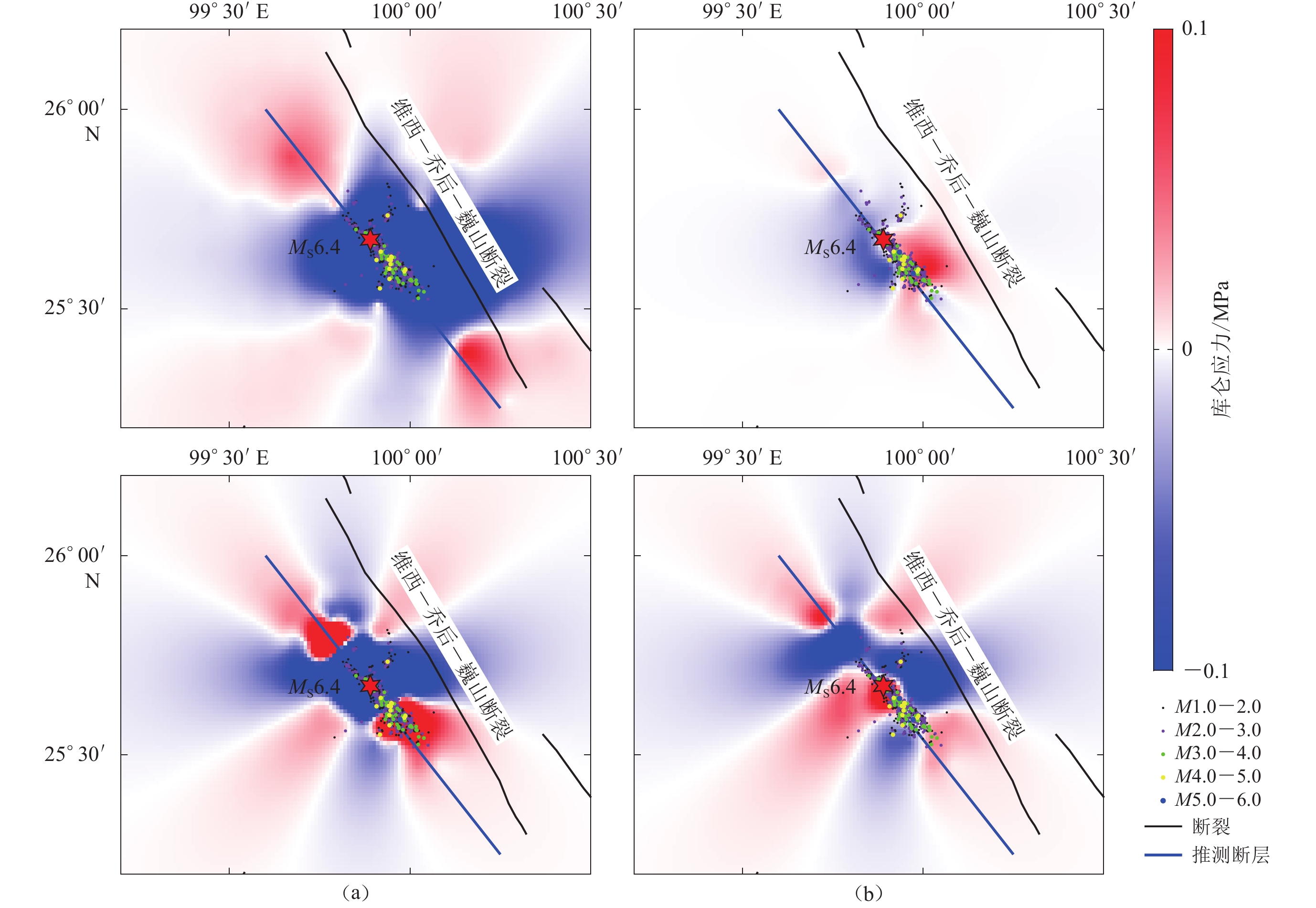Impact of stress unloading induced by the 2021 MS6.4 Yangbi,Yunnan earthquake on the surrounding areas from the joint analysis of InSAR observations and small earthquake distribution
-
摘要:
为分析2021年5月21日云南省漾濞MS6.4地震后震区应力变化对周围断层的影响,本文通过InSAR技术获得了漾濞地震的同震形变场,并联合小震分布数据建立断层破裂滑动模型,继而通过计算断层面上的同震库仑应力来评估此次地震对周边断层的影响,以便有效地分析地震破裂的时空解析度。结果显示:① 在升降轨InSAR数据获得的精细同震形变场中,升轨最大视线向形变量约为5.00 cm,降轨最大视线向形变量约为7.80 cm;② 余震精定位的主震震中为(99.89°E,25.67°N),震源深度为13.29 km,除主震之外震源深度主要集中在5—15 km;通过小震位置拟合出的发震断层走向为NW-SE (316.69°),断层倾角为88.56°,滑动角为177.97°;③ 基于InSAR同震形变场结果及小震拟合断层参数联合反演得到此次地震的断层滑动以右旋走滑为主,升轨断层最大滑动量为0.80 m,对应的深度为8.85 km,平均滑动量为0.22 m,矩震级为MW6.41;降轨的断层最大滑动量为0.30 m,对应的深度为6.88 km,平均滑动量为0.05 m,矩震级为MW6.01;7.50 km和15 km深度处断层面上的应力计算结果表明,震后断层与其周围的应力差明显减小,对周围断裂具有显著的应力卸载作用。结合余震分布区域、模拟断层迹线以及同震库仑应力逐渐减小的方向,基本可以确定漾濞地震的发震断层为维西—乔后—巍山断裂的隐伏次生断裂。该地震通过卸载周围断裂的应力释放区域应力,降低了周围断裂的地震危险性。
-
关键词:
- DInSAR /
- 2021年云南漾濞MS6.4地震 /
- 余震精定位 /
- 库仑应力
Abstract:In order to analyze the impact of stress changes on surrounding faults after the Yangbi MS6.4 earthquake in Yunnan Province on May 21, 2021, this paper used InSAR technology to perform the inversion for the coseismic deformation field of the Yangbi earthquake. Additionally, small earthquake distribution data was incorporated to establish a fault rupture sliding model. By calculating the coseismic Coulomb stress on the fault plane, the evaluation of the impact of earthquakes on surrounding faults was conducted. The analyses effectively examined the spatio-temporal resolution of earthquake rupture. The results indicate the following: ① In the high-resolution coseismic deformation field obtained from the InSAR data of the ascending orbit, the maximum line of sight deformation is approximately 5.00 cm, while for the descending orbit it is around 7.80 cm. ② The epicenter of the main shock of the Yangbi earthquake sequence, determined through precise positioning of aftershocks, is located at (99.89°E, 25.67°N) with a focal depth of 13.29 km. Apart from the main shock, the focal depths of the aftershocks are primarily concentrated in the range of 5−15 km. By analyzing the location of small earthquakes, the strike of the seismogenic fault is is determined to be NW-SE (316.69°) with a dip angle 88.56° and a slip angle 177.97°. ③ Based on the joint inversion of InSAR coseismic deformation field result and small earthquake fitting fault parameters, it was determined that the fault slip during this earthquake was primarily dextral strike-slip. The maximum slip amount observed during the ascending orbit was 0.80 m, corresponding to a depth of 8.85 km. Additionally, the average slip amount was measured to be 0.22 m, and the moment magnitude of the earthquake is MW6.41. The maximum slip of the fault during the descending orbit is 0.30 m, corresponding to a depth of 6.88 km. The average slip amount during this orbit is measured to be 0.05 m, and the moment magnitude of the earthquake is MW6.01. Furthermore, stress calculations on fault planes at the depths of approximately 7.50 km and 15 km revealed a significant decrease in stress difference between the fault itself and its surroundings after the earthquake. This suggests a notable stress unloading effect on the surrounding faults. Based on the distribution area of aftershocks, simulation of fault traces, and the direction of coseismic Coulomb stress reduction, it can be determined that the seismogenic fault of the Yangbi earthquake is a concealed secondary fault of the Weixi-Qiaohou-Weishan fault. The release of regional stress through the unloading of stress from the surrounding faults during the Yangbi earthquake has effectively reduced the seismic risk associated with these faults.
-
-
图 5 2021年漾濞MS6.4地震的余震精定位结果
(a) 小震精定位结果;(b) 沿BB′剖面的震源深度分布;(c) P波和S波的走时-震中距分布图
Figure 5. Precise locating results of the aftershocks of MS6.4 Yangbi earthquake in 2021
(a) Precise locating result based on small events;(b) Distribution of focal depths of the aftershocks along the seismic profile BB′;(c) Traveltime versus epicentral distance distribution of P and S waves
表 1 合成孔径雷达影像数据参数
Table 1 Data parameters of synthetic aperture radar image
轨道方向
(轨道号)获取时间 雷达入射角/° 轨道方位角/° 空间基线/m 时间基线/d 震前 震后 升轨(T99) 2021-05-20 2021-06-01 39.25 −12.45 19.20 12 降轨(T135) 2021-05-10 2021-05-22 39.35 −167.58 −50.35 12 表 2 不同机构给出的云南漾濞地震断层参数
Table 2 Fault parameters of Yangbi,Yunnan earthquake given by different institutions
表 3 本文所用的地壳速度结构模型(杨军等,2014)
Table 3 Crustal velocity structure model used in this study (Yang et al,2014)
地壳分层
/kmvP
/(km·s−1)vS
/(km·s−1)密度
/(kg·cm−3)0—3 5.50 2.50 2500 3—18 6.10 3.45 2810 18—25 6.35 3.55 2880 25—39 5.70 3.35 2610 39—55 6.65 3.65 2970 ≥55 7.80 4.30 3280 -
常祖峰,常昊,臧阳,代博洋. 2016. 维西—乔后断裂新活动特征及其与红河断裂的关系[J]. 地质力学学报,22(3):517–530. doi: 10.3969/j.issn.1006-6616.2016.03.009 Chang Z F,Chang H,Zang Y,Dai B Y. 2016. Recent active features of Weixi-Qiaohou fault and its relationship with the Honghe fault[J]. Journal of Geomechanics,22(3):517–530 (in Chinese).
崔华伟,郑建常,万永革,程宇豪,杨帆,孙庆山,赵瑞,许鑫,柴光斌. 2022. 2021年云南漾濞MS6.4地震序列发震构造及其与2013年洱源、2017年漾濞地震的异同[J]. 地球物理学报,65(2):620–636. doi: 10.6038/cjg2022P0425 Cui H W,Zheng J C,Wan Y G,Cheng Y H,Yang F,Sun Q S,Zhao R,Xu X,Chai G B. 2022. The seismogenic structure of the 2021 Yunnan Yangbi MS6.4 earthquake sequence and the difference between the Eryuan earthquake in 2013,Yangbi earthquake in 2017 and 2021[J]. Chinese Journal of Geophysics,65(2):620–636 (in Chinese).
邓起东. 1996. 中国活动构造研究[J]. 地质论评,42(4):295–299. doi: 10.3321/j.issn:0371-5736.1996.04.003 Deng Q D. 1996. Active tectonics in China[J]. Geological Review,42(4):295–299 (in Chinese).
高原,周蕙兰,郑斯华,马林,车时,刘卫红. 1997. 测定震源深度的意义的初步讨论[J]. 中国地震,13(4):321–329. Gao Y,Zhou H L,Zheng S H,Ma L,Che S,Liu W H. 1997. Preliminary discussion on implication of determination on source depth of earthquake[J]. Earthquake Research in China,13(4):321–329 (in Chinese).
国家地震局震害防御司. 1995. 中国历史强震目录: 公元前23世纪—公元1911年[M]. 北京: 地震出版社: 1−514. Department of Earthquake Disaster Prevention, State Seismological Bureau. 1995. Catalogue of Historical Strong Earthquakes in China: 23rd Century BC−1911 AD[M]. Beijing: Seismological Press: 1−514 (in Chinese).
胡鸿翔,陆涵行,王椿镛,何正勤,朱良保,颜其中,樊跃新,张国庆,邓英娥. 1986. 滇西地区地壳结构的爆破地震研究[J]. 地球物理学报,29(2):133–144. doi: 10.3321/j.issn:0001-5733.1986.02.004 Hu H X,Lu H X,Wang C Y,He Z Q,Zhu L B,Yan Q Z,Fan Y X,Zhang G Q,Deng Y E. 1986. Explosion investigation of the crustal structure in western Yunnan Province[J]. Acta Geophysica Sinica,29(2):133–144 (in Chinese).
李佳,李志伟,丁晓利,朱珺,汪长城. 2011. 强噪声SAR干涉图的等值线中值-Goldstein二级滤波[J]. 遥感学报,15(4):750–765. doi: 10.11834/jrs.20110151 Li J,Li Z W,Ding X L,Zhu J,Wang C C. 2011. Filtering strong noisy synthetic aperture radar (SAR) interferogram with integrated Contoured Median and Goldstein two-step filter[J]. Journal of Remote Sensing,15(4):750–765 (in Chinese).
宁津生,王正涛. 2006. 测绘学科发展综述[J]. 测绘科学,31(1):9–16. doi: 10.3771/j.issn.1009-2307.2006.01.001 Ning J S,Wang Z T. 2006. A summary of the newest progress of surveying and mapping (S&M)[J]. Science of Surveying and Mapping,31(1):9–16 (in Chinese).
万永革,沈正康,刁桂苓,王福昌,胡新亮,盛书中. 2008. 利用小震分布和区域应力场确定大震断层面参数方法及其在唐山地震序列中的应用[J]. 地球物理学报,51(3):793–804. doi: 10.3321/j.issn:0001-5733.2008.03.020 Wan Y G,Shen Z K,Diao G L,Wang F C,Hu X L,Sheng S Z. 2008. An algorithm of fault parameter determination using distribution of small earthquakes and parameters of regional stress field and its application to Tangshan earthquake sequence[J]. Chinese Journal of Geophysics,51(3):793–804 (in Chinese).
王长在,吴建平,房立华,王未来. 2011. 2009年姚安地震序列定位及震源区三维P波速度结构研究[J]. 地震学报,33(2):123–133. Wang C Z,Wu J P,Fang L H,Wang W L. 2011. Relocation of aftershocks of the 2009 Yaoan MS6.0 earthquake and 3-D P-wave velocity structure around its source region[J]. Acta Seismologica Sinica,33(2):123–133 (in Chinese).
王若柏,谢觉民,薄万举. 2000. 跨断层的定点地壳形变研究及发展前景[J]. 国际地震动态,(6):5–9. doi: 10.3969/j.issn.0253-4975.2000.06.002 Wang R B,Xie J M,Bo W J. 2000. Studies on fixed-point crustal deformation of cross-faults and development prospects[J]. Recent Developments in World Seismology,(6):5–9 (in Chinese).
王莹,赵韬,胡景,刘春. 2021. 2021年云南漾濞6.4级地震序列重定位及震源机制解特征分析[J]. 地震地质,43(4):847–863. doi: 10.3969/j.issn.0253-4967.2021.04.007 Wang Y,Zhao T,Hu J,Liu C. 2021. Relocation and focal mechanism solutions of the 2021 Yangbi,Yunnan MS6.4 earthquake sequence[J]. Seismology and Geology,43(4):847–863 (in Chinese).
徐锡伟,闻学泽,郑荣章,马文涛,宋方敏,于贵华. 2003. 川滇地区活动块体最新构造变动样式及其动力来源[J]. 中国科学:D辑,33(增刊):151–162. Xu X W,Wen X Z,Zheng R Z,Ma W T,Song F M,Yu G H. 2003. Pattern of latest tectonic motion and its dynamics for active blocks in Sichuan-Yunnan region,China[J]. Science in China:Series D,33(S2):210–226.
杨军,苏有锦,陈佳,叶泵,李孝宾,金明培,王宝善. 2014. 利用CAP方法快速计算云南地区中小地震震源机制解[J]. 中国地震,30(4):551–559. doi: 10.3969/j.issn.1001-4683.2014.04.008 Yang J,Su Y J,Chen J,Ye B,Li X B,Jin M P,Wang B S. 2014. Fast CAP calculation of focal mechanism of moderate and small earthquake in the Yunnan area[J]. Earthquake Research in China,30(4):551–559 (in Chinese).
杨九元,温扬茂,许才军. 2021. 2021年5月21日云南漾濞MS6.4地震:一次破裂在隐伏断层上的浅源走滑事件[J]. 地球物理学报,64(9):3101–3110. doi: 10.6038/cjg2021P0408 Yang J Y,Wen Y M,Xu C J. 2021. The 21 May 2021 MS6.4 Yangbi (Yunnan) earthquake:A shallow strike-slip event rupturing in a blind fault[J]. Chinese Journal of Geophysics,64(9):3101–3110 (in Chinese).
易桂喜,龙锋,梁明剑,张会平,赵敏,叶有清,张致伟,祁玉萍,王思维,宫悦,乔惠珍,汪智,邱桂兰,苏金蓉. 2017. 2017年8月8日九寨沟M7.0地震及余震震源机制解与发震构造分析[J]. 地球物理学报,60(10):4083–4097. doi: 10.6038/cjg20171033 Yi G X,Long F,Liang M J,Zhang H P,Zhao M,Ye Y Q,Zhang Z W,Qi Y P,Wang S W,Gong Y,Qiao H Z,Wang Z,Qiu G L,Su J R. 2017. Focal mechanism solutions and seismogenic structure of the 8 August 2017 M7.0 Jiuzhaigou earthquake and its aftershocks,northern Sichuan[J]. Chinese Journal of Geophysics,60(10):4083–4097 (in Chinese).
张建国. 2009. 中越红河断裂活动性研究[D]. 合肥: 中国科学技术大学: 1−208. Zhang J G. 2009. Study on the Activity of Zhongyue Honghe Fault[D]. Hefei: University of Science and Technology of China: 1−208 (in Chinese).
张克亮,甘卫军,梁诗明,肖根如,代成龙,王阅兵,李长军,张玲,马广庆. 2021. 2021年5月21日MS6.4漾濞地震GNSS同震变形场及其约束反演的破裂滑动分布[J]. 地球物理学报,64(7):2253–2266. doi: 10.6038/cjg2021O0524 Zhang K L,Gan W J,Liang S M,Xiao G R,Dai C L,Wang Y B,Li Z J,Zhang L,Ma G Q. 2021. Coseismic displacement and slip distribution of the 2021 May 21,MS6.4,Yangbi earthquake derived from GNSS observations[J]. Chinese Journal of Geophysics,64(7):2253–2266 (in Chinese).
张中杰,白志明,王椿镛,吕庆田,滕吉文,李继亮,孙善学,王新征. 2005. 冈瓦纳型和扬子型地块地壳结构:以滇西孟连—马龙宽角反射剖面为例[J]. 中国科学:D辑,34(5):387–392. Zhang Z J,Bai Z M,Wang C Y,Teng J W,Lü Q T,Li J L,Sun S X,Wang X Z. 2005. Crustal structure of Gondwana- and Yangtze-typed blocks:An example by wide-angle seismic profile from Menglian to Malong in western Yunnan[J]. Science in China:Series D,48(11):1828–1836. doi: 10.1360/03yd0547
赵博,高原,马延路. 2022. 2021年5月21日云南漾濞MS6.4地震序列重新定位、震源机制及应力场反演[J]. 地球物理学报,65(3):1006–1020. doi: 10.6038/cjg2022P0497 Zhao B,Gao Y,Ma Y L. 2022. Relocations,focal mechanisms and stress inversion of the May 21th 2021 Yangbi MS6.4 earthquake sequence in Yunnan,China[J]. Chinese Journal of Geophysics,65(3):1006–1020 (in Chinese).
中国地震局地质研究所. 2021. 云南漾濞6.4级地震科考取得阶段性进展[EB/OL]. [2021-06-10]. https://www.eq-igl.ac.cn/zhxw/info/2021/33882.html. Institute of Geology, China Earthquake Administration. 2021. Recent progress in Yangbi 6.4 magnitude earthquake scientific survey in Yunnan Province[EB/OL]. [2021-06-10]. https://www.eq-igl.ac.cn/zhxw/info/2021/33882.html (in Chinese).
中国地震台网中心. 2021. 2021年5月21日21时48分云南漾濞6.5级地震中国台网震相数据集[DB/OL]. [2021-08-08]. https://data.earthquake.cn/datashare/report.shtml?PAGEID=datasourcelist&dt=6fd7c34f900d49df8e0a318fb0e50d1d. China Earthquake Network Center. 2021. Seismic phase dataset of M6.5 Yangbi, Yunnan earthquake at 21:48 on 21 May 2021 provided by China Earthquake Network Center[DB/OL]. [2021-08-08]. https://data.earthquake.cn/datashare/report.shtml?PAGEID=datasourcelist&dt=6fd7c34f900d49df8e0a318fb0e50d1d (in Chinese).
朱俊文,姚赟胜,张波. 2021. 基于Sentinel-1A数据反演漾濞MS6.4地震的同震形变场及断层几何参数[J]. 地震工程学报,43(4):784–790. doi: 10.3969/j.issn.1000-0844.2021.04.784 Zhu J W,Yao Y S,Zhang B. 2021. Inversion of the coseismic deformation field and fault geometric parameters of the Yangbi MS6.4 earthquake based on Sentinel-1A data[J]. China Earthquake Engineering Journal,43(4):784–790 (in Chinese).
GCMT. 2021. Global CMT catalog[DB/OL]. [2021-08-08]. https://www.globalcmt.org/cgi-bin/globalcmt-cgi-bin/CMT5/form?itype=ymd&yr=2021&mo=5&day=15&otype=ymd&oyr=2021&omo=5&oday=25&jyr=1976&jday=1&ojyr=1976&ojday=1&nday=1&lmw=0&umw=10&lms=0&ums=10&lmb=0&umb=10&llat=25&ulat=27&llon=99&ulon=101&lhd=0&uhd=1000<s=-9999&uts=9999&lpe1=0&upe1=90&lpe2=0&upe2=90&list=0.
Japan Aerospace Exploration Agency. 2021. Precise global digital 3D map: “ALOS World 3D”[EB/OL]. [2021-08-08]. https://www.eorc.jaxa.jp/ALOS/en/dataset/aw3d_e.htm.
King G C P,Stein R S,Lin J. 1994. Static stress changes and the triggering of earthquakes[J]. Bull Seismol Soc Am,84(3):935–953.
Long F,Yi G X,Wang S W,Qi Y P,Zhao M. 2019. Geometry and tectonic deformation of the seismogenic structure for the 8 August 2017 MS7.0 Jiuzhaigou earthquake sequence,northern Sichuan,China[J]. Earth Planet Phys,3(3):253–267. doi: 10.26464/epp2019027
Okada Y. 1985. Surface deformation due to shear and tensile faults in a half-space[J]. Bull Seismol Soc Am,75(4):1135–1154. doi: 10.1785/BSSA0750041135
Orlin J B. 1993. A faster strongly polynomial minimum cost flow algorithm[J]. Oper Res,41(2):338–350. doi: 10.1287/opre.41.2.338
Peltzer G,Rosen P. 1995. Surface displacement of the 17 May 1993 Eureka Valley,California,earthquake observed by SAR interferometry[J]. Science,268(5215):1333–1336. doi: 10.1126/science.268.5215.1333
Scholz C H. 2002. The Mechanics of Earthquakes and Faulting[M]. 2nd ed. Cambridge: Cambridge University Press: 1−504.
Symithe S J,Calais E,Haase J S,Freed A M,Douilly R. 2013. Coseismic slip distribution of the 2010 M7.0 Haiti earthquake and resulting stress changes on regional faults[J]. Bull Seismol Soc Am,103(4):2326–2343. doi: 10.1785/0120120306
USGS. 2021. M6.1: 25 km NW of Dali, China[EB/OL]. [2021-08-08]. https://earthquake.usgs.gov/earthquakes/eventpage/us7000e532/executive.
Zhang H J,Thurber C H. 2003. Double-difference tomography:The method and its application to the Hayward fault,California[J]. Bull Seismol Soc Am,93(5):1875–1889. doi: 10.1785/0120020190





 下载:
下载:







